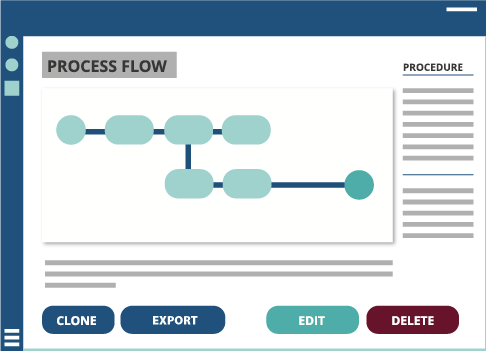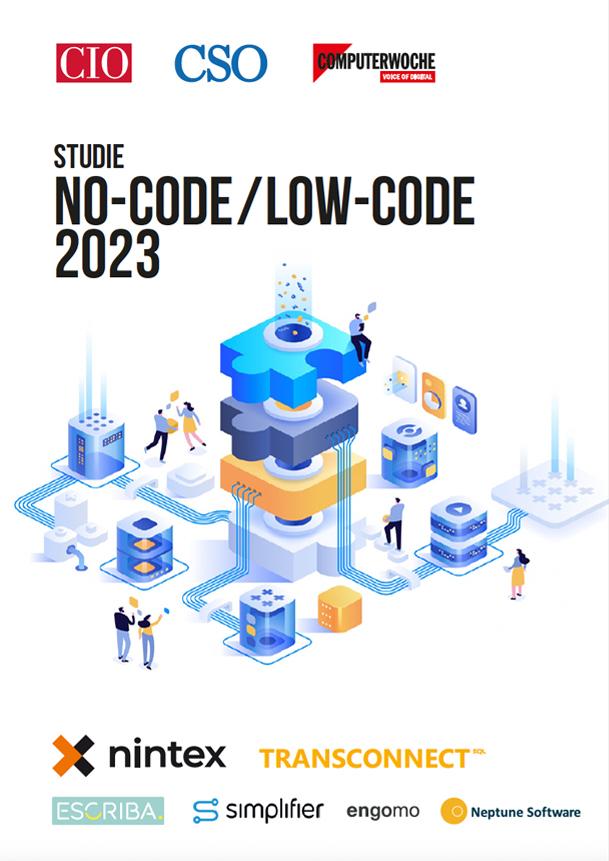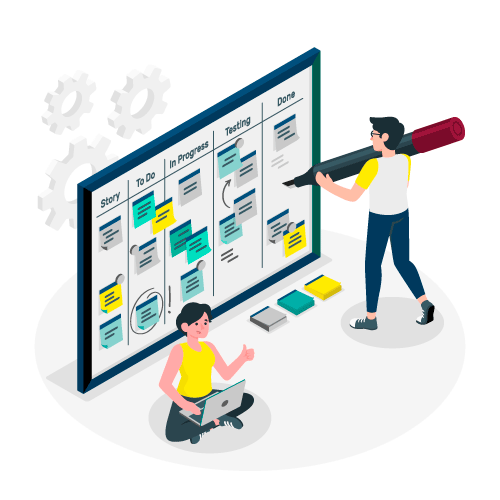Want to know more about ESCRIBA?
Simply register here for our e-mail distribution list.

The development of software with no- and low-coding has become a real trend topic. Some experts even speak of a software revolution. Market researchers from the analyst firm Gartner predict that as early as 2025, around two-thirds of all applications will be created using a no- or low-code platform.
The rapid rise of this modern form of software development is obvious: If companies want to successfully shape their digital transformation, they must be able to provide digital applications and services quickly and flexibly for themselves and their customers. To achieve this goal with classic programming, the required IT resources are simply not available. This is where no- and low-code tools steps in. They transform the way companies create software.

Max Fuchs
Project Manager HR-IT Strategy, Würth IT GmbH
Behind no- and low-coding lays a new way of creating software. Instead of writing several thousand lines of code manually, digital applications can be created with little or no programming knowledge using a no/low-code platform. This works because the platform consists of prefabricated code modules that execute specific functions.
Users can simply click together the blocks and modules using a graphical user interface and select and control functions, commands, and conditions by using existing selection fields. When applications (apps) are created this way, they are referred to as no-coding because no programming language is required. This means that even employees without special IT know-how can create software independently using no-code.
Low-coding – as the name suggests – involves working with a minimum of code. This approach is primarily aimed at developers who can create software much faster and more efficiently thanks to the prefabricated modules. Special requirements or separate interfaces are then programmed on the platform with little coding effort. In this way, even complex applications are created in less time and with high quality.
You are currently viewing a placeholder content from YouTube. To access the actual content, click the button below. Please note that doing so will share data with third-party providers.
More InformationNo- and low-code platforms do not compete with existing ERP and CRM systems but are the ideal complement. Anyone who wants to quickly establish digital business processes and applications today can no longer avoid no- and low-coding. Learn more about the new key technology for end-to-end processes and customer experience in the video.
Processes in companies are often long-winded, slow and difficult to understand. Manual work steps and many interfaces make them expensive and sometimes of inadequate quality. The bottom line is a poor perception and thus a negative customer or employee experience.
Digital processes are faster, and customers receive immediate feedback. Processes and workflows should be easy to execute and implemented digitally – ideally end-to-end. Well-implemented digital business processes are based on automated workflows that are easy to monitor and measure and can therefore be continuously improved. This creates a customer and employee experience that stands out from the rest.

No- and low-code creates entirely new opportunities to digitalize and automate internal company processes. Data is now only stored in a central location and retrieved via applications or interfaces and used for further work steps. Depending on the use case, entire documents can be created at the push of a button, approval processes can be controlled in a lean manner, or automatic reminders can be sent by e-mail.
When implementing digital business processes, it is advisable to first analyze your own workflows and identify the potential for optimization. By using digital workflows, individual process steps can often be eliminated, for example manual printing, sending, scanning, but also checking loops or approvals can be reduced by system-supported plausibility checks. In this way, working with no- and low-code not only paves the way from analog to digital or from manual to automated, but is also a driver for lasting process optimization.
No-code/low-code applications are already of central importance for a large proportion of business areas and are therefore strategically important modules in the IT landscape. This was the result of a survey of more than 600 IT managers, decision-makers, and specialists as part of a study with CIO, CSO and COMPUTERWOCHE.

In the future, business processes will be even more data-driven, while at the same time continuing to involve administrative activities. Being able to react to changing conditions quickly, flexibly and without great effort must become the standard. (Enterprise) service management based on a no/low code platform closes existing digitalization gaps and paves the way for agile, self-determined work.
Get the whole study here with all results, statistics, and analysis – The study is only available in German
Many companies are suffering from the ongoing shortage of IT specialists. As a result, there is a very high prioritization of which business processes are digitalized. Internal workflows and everyday processes that do not directly serve the value chain often fall through the cracks when it comes to digitalization. No- and low-coding platforms can solve the shortage of IT resources and the associated digitalization backlog.
First and foremost, no- and low-code Excel is getting a raw deal. Our study on digital HR, conducted together with Foundry, revealed that more than 90 percent of respondents consider Excel to be important for their daily work. For business, Excel is undoubtedly a pragmatic solution because it allows departments to keep their processes running independently of IT. However, Excel also has its limitations, making processes inefficient, inconvenient, and error-prone, and therefore quickly becoming a risk factor.
The no-code/low-code study also shows that the pressure is particularly strong among large companies to replace Excel-based tools with contemporary IT applications and apps that enable digital end-to-end processes and workflows. With a no-code/low-code platform that complements existing back-end systems, companies can provide business departments with a powerful development tool.
Internal Excel lists offer enormous potential for digitalizing and in some cases automating data and workflows. Thanks to no-coding, the specialist department can convert even simple processes from Excel directly into an app. Together with IT or an external partner, even more complex processes and applications can be created very quickly using low-coding. This type of shared development already significantly reduces the required IT capacities.
No- and low-code platforms therefore involve the later users of the software in the creation process. At this point at the latest, skeptical IT experts bring up the risk of shadow IT. By shadow IT, they mean data-processing applications and programs that are used in the company without the involvement of the IT department and therefore do not comply with the requirements and supervision of the central corporate IT department. There are fears of data protection and compliance violations and further audit risks.
So, does the use of no- and low-code platforms increase the risks of shadow IT? Our answer is no. When implemented systematically, no/low-code tools offer the opposite: departments that are not provided with a satisfactory IT solution usually help themselves – often with half-baked solutions. In most cases, these are the Excel spreadsheets already mentioned. If smart employees then rely on macros or integrated Access databases and send them in umpteen versions by e-mail, all the feared risks of shadow IT are already a reality.
If a company provides its departments with a standardized development environment – such as a no/low-code platform – citizen developers in the various departments can digitalize their tasks independently and automate some of them. The IT department creates the appropriate framework for this and, at best, acts as a sparring partner for questions or for applications that can be refined and expanded via low coding.
It is important that Citizen Development is understood as a holistic approach within the company. A pilot project with the appropriate employees from the business and IT departments is a good approach. However, companies benefit on a larger scale if they establish Citizen Development in several, if not all, areas. This means that the course and the associated change process should be supported and, at best, driven by top management. Implemented in this way, Citizen Development not only saves valuable time and IT resources, but also empowers and qualifies the company’s own employees, which in times of the “war for talent” is also a good measure for employee satisfaction and retention. Finally, working with a no/low code platform is also the perfect introduction to agile methods and agile thinking. This develops a better understanding of digitalization and IT throughout the entire company.

Dr. Juergen Erbeldinger
CEO and Founder of the ESCRIBA AG
If a no/low-code platform is in use, small projects can be implemented and introduced within hours, medium-sized projects in a few days, and high-level projects in a few weeks or months. Here it becomes clear why no- and low-coding is very well suited for the start or the use of agile methods. Instead of large and lengthy IT projects, small and fast application developments take place, which often even achieve a higher benefit level. If software is developed where it is ultimately used, it is more readily accepted and used more intensively.

Agile working models are based on breaking down a problem into time segments rather than content milestones. In these short time segments, also called sprints, prototypes can be created quickly and easily with no/low coding and tested immediately in practice. In this way, the iterative, agile way of working “create, try out, use and improve or discard” replaces a classic conceptual design and waterfall projects.
If companies also manage to provide their employees with an agile environment with mixed teams – i.e., across departments and hierarchies – a high level of agility and flexibility can be achieved without the work losing quality. In this way, the no- and low-coding approach also pays off in the long term for the company’s own organizational development as well as changes in the range of services. All of this together also helps to improve IT-business alignment and promotes the breaking down of entrenched roles and structures in software development.
No- and low-code can be part of any IT strategy and any business unit digitalization strategy. There are different platforms for different application scenarios. That is why we believe that special platforms will prevail in no/low coding. Although one-for-all platforms can be used universally in principle, they lack the appropriate depth when it comes to complex, specialist processes. Specialized platforms sometimes come with suitable presetting and ready-made configurations, so that applications are productive even faster.
For example, there are platforms that focus on financial processes or production. In the future, many companies will therefore have not just one, but several no/low code platforms. In larger companies and groups, we assume an average of three to four platforms for different fields: e.g., administrative processes with data and documents, production, logistics, and procurement, as well as special applications with interlinking to sensor technology, IoT, and IIoT.
ESCRIBA helps especially with data- and document-intensive processes. Our developments are designed to simplify administrative processes and come with many preset processes, templates, and evaluations – especially when it comes to HR service management. Therefore, our no/low-code applications are ready for use immediately after setup at the customer’s site. We are a German provider and therefore very close to the customer in the German and European area, but above all we have a different and deeper understanding of the German culture and legal area.
A no/low-code platform offers a range of functions that can be switched on at the push of a button – this corresponds to a disruption of classic programming with manual coding. The platforms can therefore be used in a wide variety of areas and industries, and a large proportion of processes and data can be digitally mapped and automated via no/low-code apps. However, the providers of the platforms often have certain core industries that shape the scope of functions. You should therefore take this and the following criteria into account when selecting the right no/low code platform for your company.
These include, for example, integration, scalability, extensibility or multi-system or multi-client capability.
Here it must be decided whether the platform is to be operated on-premises, in the cloud or in a hybrid scenario and who is responsible for operation and application management.
Define what data is processed, what requirements are placed on a role and authorization system, and what staging and backup solutions the platform must have.
Here, attention must also be paid to languages, time zones, and the like.
Which costs are fixed, which scale with usage intensity, and which scenario better fits your IT and growth strategy?
Deciding on the degree of dependency on a vendor should not be shortchanged in the selection process. Clarify in advance the availability of resources for this type of application, software, and technology in the company and on the market. We recommend that you ensure that industry standards are used for the solutions deployed. This applies both to the process level, where common standards for process modulation such as BPMN should be used, and to the code, where a common programming language should also be used. API standards should also be used in interfaces, and systems with a large selection of existing APIs for connecting other systems should be preferred.
Many manufacturers also offer certified partners as service providers for no- and low-code projects. In these cases, make sure that the partner has a comprehensive understanding of the technology, appropriate domain knowledge and know-how for the process transfer to the platform. ESCRIBA is happy to advise and support you in this regard.

Christian Keller
Business Development
Then please feel free to make an appointment with me directly. We will discuss your requirements and possible solutions based on the ESCRIBA ECAP NLC platform in a personal meeting. I look forward to your enquiry.
You are currently viewing a placeholder content from Default. To access the actual content, click the button below. Please note that doing so will share data with third-party providers.
More InformationWhy ESCRIBA? ESCRIBA stands for 25 years of living digitalisation in companies. Our heart beats for digital processes and scalable technologies, which we develop on our own no- and low-code platform. With this, we create groundbreaking results in a short time and bring your software world up to speed. Choose from our wide range of pre-packaged solutions or let us develop customised software for your personal use. more >>
Want to know more about ESCRIBA?
Simply register here for our e-mail distribution list.
You are currently viewing a placeholder content from Facebook. To access the actual content, click the button below. Please note that doing so will share data with third-party providers.
More InformationYou are currently viewing a placeholder content from Instagram. To access the actual content, click the button below. Please note that doing so will share data with third-party providers.
More InformationYou are currently viewing a placeholder content from Google Maps. To access the actual content, click the button below. Please note that doing so will share data with third-party providers.
More InformationYou are currently viewing a placeholder content from X. To access the actual content, click the button below. Please note that doing so will share data with third-party providers.
More Information